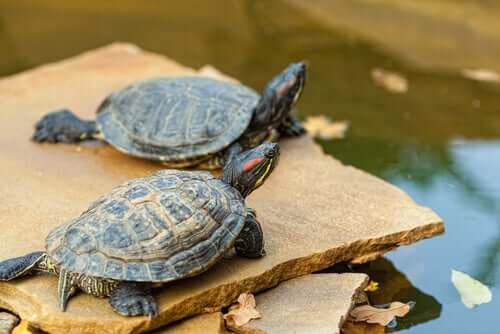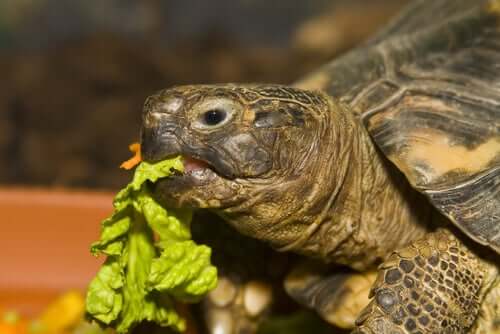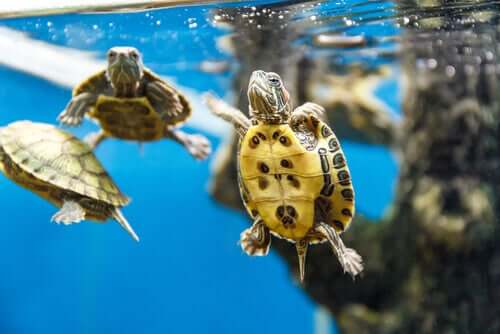How to Care for Your Pet Aquatic Turtle


Written and verified by the lawyer Francisco María García
Having a pet aquatic turtle is all the rage, especially among children. But, while these reptiles require relatively simple maintenance, they also need some basic care to be in optimal shape. So, today we’d like to tell you how to best care for one.
Essential care of your pet aquatic turtle
1. Setting up the ideal tank
A pet aquatic turtle will spend most of their life inside their tank. So, the first step to caring for them is to choose the tank carefully and conscientiously. It’s in this pool of water where your pet must find optimal conditions for their development.
When you select a tank, keep in mind that aquatic turtles will grow quite a lot after their arrival at your home. In general, people acquire young animals that are just a few weeks old, so you can assume that yours will quadruple in size before they reach adulthood.
So, find out what species of turtle you’re trying to adopt before you do and then choose an appropriate tank for them to live in. Aquatic turtles are quite active and enjoy swimming freely. Not only to exercise but to express themselves.
In short, the tank where your turtle is to live should be large enough to allow them to swim and move comfortably. In general, we recommend for the tank to be at least three or four times larger than your turtle.
2. Preparing the tank

So, this means that your turtle will spend many hours underwater. But also that they’ll need a dry space where they can sunbathe, dry out and regulate their temperature. You can install a lamp in a strategic corner of the tank to guarantee the availability of light, mainly during winter.
Also, the best temperature for the water in the tank should be between 75 and 79ºF. There are heating systems out there which can maintain this ideal temperature throughout the year.
3. Balanced diet and nutrition

Nutrition is one of the most basic needs of an aquatic turtle. It’s essential for the development of their physical and cognitive abilities. The perfect diet for your turtle will depend on their age, species and overall health.
In general, an aquatic turtle will need to consume a greater amount of protein during their growing period, which is up to their third year of life. It’s in this first phase of development that the reptile will grow fast. So, their diet must contain ample sources of animal protein such as worms, crickets, small fish and crustaceans.
Then, after their third year of life, a turtle will gradually decrease their consumption of animal protein. They’ll then mostly become herbivorous. You should incorporate edible seaweed, green leaves, and lettuce to their diet. This will prevent constipation, a very common problem in these species.
You can find food for aquatic turtles in most pet shops. This kind of food is good because it contains balanced proportions of all nutrients. They’re designed according to the nutritional requirements of these reptiles. However, it’s also highly recommended for you to incorporate fresh and natural foods into their diet. It’ll supplement your turtle’s nutrition.
4. Toxic food for pet aquatic turtles
This is a list of toxic foods that you shouldn’t feed your pet aquatic turtle with:
- Vegetables: Never add peppers, beans, mushrooms, asparagus, sweet potatoes, or pumpkins in your turtle’s diet.
- Meat: It’s never a good idea to give turtles red or white meats high in saturated fat. The best sources of animal proteins are fish, worms, crustaceans and small insects.
- Fruit: The best fruit for turtles are apples, pears, watermelons, and melons. Don’t feed them citrus fruits or bananas.
5. Preventive medicine for your pet aquatic turtle

So, the best way to keep them in good health is to maintain optimal hygiene in the tank. Change their water at least once a week and deep clean it at least once every two months. Use a neutral soap and warm water for that purpose.
Last but not least, take your turtle to the vet every six months for regular checkups.
All cited sources were thoroughly reviewed by our team to ensure their quality, reliability, currency, and validity. The bibliography of this article was considered reliable and of academic or scientific accuracy.
- Tetra.net. Iniciación al cuidado de tortugas de agua. Extraído de: https://www.tetra.net/~/media/downloads/brochures_spain/t064747-turtle_es-brochure.pdf
- petco.com. Tortuga acuática. Extraído de: https://www.petco.com.mx/pdf/Tortuga%20Acuatica%20ok.pdf
- Sodagari, H. R., Habib, I., Shahabi, M. P., Dybing, N. A., Wang, P., & Bruce, M. (2020). A review of the public health challenges of Salmonella and turtles. Veterinary sciences, 7(2), 56.
- Wappel, S. M., & Schulte, M. S. (2004). Turtle care and husbandry. Veterinary Clinics: Exotic Animal Practice, 7(2), 447-472.
- Köchli, B. (2018). Turtles as a patient. Svensk Veterinärtidning, 70(9), 10-12.
This text is provided for informational purposes only and does not replace consultation with a professional. If in doubt, consult your specialist.